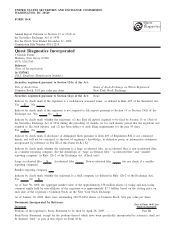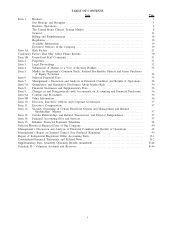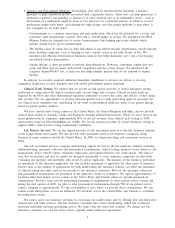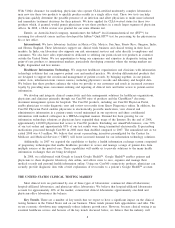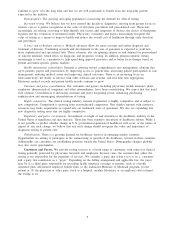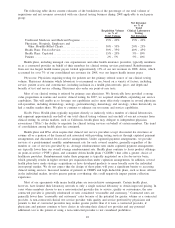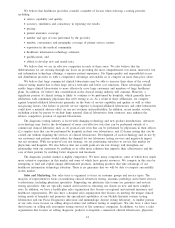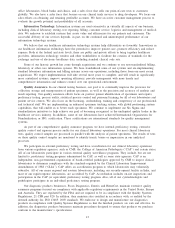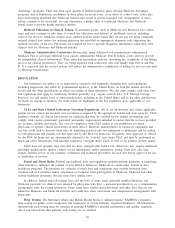Quest Diagnostics 2008 Annual Report Download - page 18
Download and view the complete annual report
Please find page 18 of the 2008 Quest Diagnostics annual report below. You can navigate through the pages in the report by either clicking on the pages listed below, or by using the keyword search tool below to find specific information within the annual report.
•Genetics and Personalized Medicine. Increasingly, tests will be introduced that determine a patient’s
genotype or gene expression profile associated with a particular disease. These tests can help physicians to
determine a patient’s susceptibility to disease or to tailor medical care to an individual’s needs – such as
determining if a medication might be more or less effective for a particular person, or which of several
medications might work better, and tailoring the right dosage once the proper medicine is prescribed. A
few examples are set forth below:
- Carbamazepine is a common anti-seizure and pain medication, which has the potential for a severe and
sometimes fatal dermatologic reaction. This risk is 10-fold higher in Asians. We introduced the HLA
(Human Leukocyte Antigen) test to screen Asian patients, thus helping physicians identify which
patients should not be given carbamazepine.
- The leading cause of vision loss in older individuals is age-related macular degeneration, which typically
starts showing symptoms, such as blurring in one’s central vision, in the fifth decade of life. We
introduced the Macular Degeneration Mutation Analysis that helps determine one’s risk of developing
age-related macular degeneration.
- Aspirin therapy is often prescribed to prevent atherothrombosis. However, sometimes aspirin does not
work, and there may be issues with patient compliance and the correct dosage. We introduced the
Corgenix AspirinWorks威test, a urine test that helps identify patients that do not respond to aspirin
therapy.
In addition, we recently acquired additional biomarker capabilities to advance our efforts to develop
companion diagnostics for new therapies that will enable personalized patient treatment.
Clinical Trials Testing. We believe that we are the second largest provider of central laboratory testing
performed in connection with clinical research trials on new drugs and vaccines. Clinical research trials are
required by the FDA and other international regulatory authorities to assess the safety and efficacy of new drugs
and vaccines. We see opportunities to develop pharmacogenetic tests to help speed drug approval processes for
our clinical trials customers and, capitalizing on the trend to personalized medicine, better focus patient therapy
based on patient genetic markers.
We have clinical trials testing centers in the United States, the United Kingdom and India, and we provide
clinical trials testing in Australia, China and Singapore through affiliated laboratories. While we serve most of the
major pharmaceutical companies, approximately 40% of our net revenues from clinical trials testing in 2008
represented testing for GlaxoSmithKline plc (GSK). We are the primary provider of central laboratory testing to
support GSK’s clinical trials testing requirements worldwide.
Life Insurer Services. We are the largest provider of risk assessment services to the life insurance industry
in the United States and Canada. We also provide risk assessment services for insurance companies doing
business in many countries outside the United States. In 2008, we began providing risk assessment services in
India.
Our risk assessment services comprise underwriting support services to the life insurance industry including
teleunderwriting, specimen collection and paramedical examinations, clinical testing, medical record retrieval, case
management, motor vehicle reports, telephone inspections, prescription histories and credit checks. The clinical
tests that we perform and data we gather are designed specifically to assist insurance companies in objectively
evaluating the mortality and morbidity risks posed by policy applicants. The majority of the testing is performed
on specimens of life insurance applicants, but also includes specimens of applicants for other types of insurance.
Factors such as the number of applications for fully-underwritten life insurance policies can affect the utilization
of clinical testing and other services we provide to our insurance customers. Most of our specimen collections
and paramedical examinations are performed at the applicant’s home or workplace. We operate approximately 75
locations other than patient service centers in the United States and Canada where we provide paramedical
examinations. We have been actively performing paramedical examinations in select patient service centers and
during the first quarter of 2009, we plan to offer paramedical examinations through 500 of our patient service
centers, bringing to approximately 575 the total number of sites where we provide these examinations. We also
contract with third parties at over an additional 125 locations across the United States and Canada to coordinate
providing these exams.
We seek to grow our insurance revenues by increasing our market share and by offering new and innovative
clinical tests and other services. Our life insurance customers have been consolidating, which has resulted in
increased individual customer purchasing power. We expect that this trend will continue. We charge our life
insurance customers on a fee-for-service basis, typically under multi-year agreements.
6



